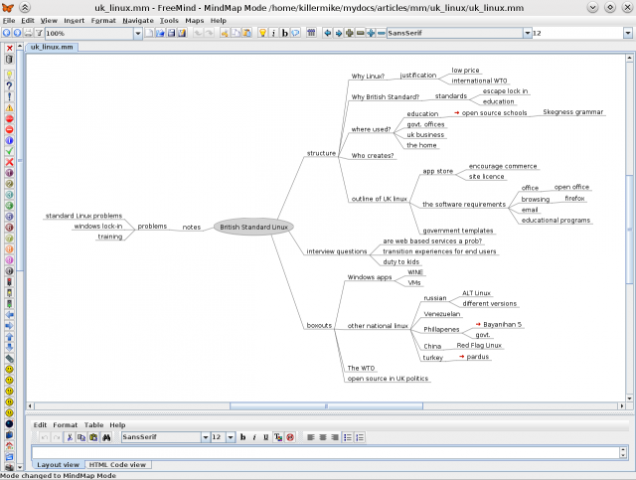Using Freemind as a Writing Planner

Freemind, the open source Java based mind mapping application, makes a great writing planning tool. A final release of version 0.9 has been a long time coming, but the current release candidates are very usable and stable, and I would recommend making the extra effort to install one of these rather than an 0.8 “stable” release. Fortunately, the 0.9 RCs have made it into the standard Ubuntu 10.04 repository.
Thankfully, Freemind is a keyboard friendly application. The first thing I do when I'm using Freemind to plan out an article is to rename the first node by hitting F2. You can add new nodes by hitting the insert key and then typing in a title for the node.
At the beginning of the process, I prefer an approach of dumping ideas into the mind map rather than worrying about where it belongs in the overall structure. Often, I read up on the subject while alt-tabbing back to Freemind to make notes.
Before long, you'll want to save the file, and this reveals a weakness of Freemind. Owing to the program's Java roots, the file requester is a bit cumbersome and lacks directory hot links. Typically, however, it's an awkwardness that you'll only have to deal with once per project. However, the Java nature of the program means that the user interface couldn't really be described as lightning fast. By the same token, initial application launch time is on the slow side. Neither of these problems make much difference for typical desktop usage but Freemind wouldn't be my first choice in a resource constrained environment.
Once I've got a few ideas onto the page, in the form of branches that are linked to the initial node, I start to think about structure. I've seen mind maps that go off in all directions, but my view is that a document such as the main body of a magazine article is ultimately linear, and for this reason, I like to end up with a mind map that is as vertical as possible. It's like a game of patience, and I tend to spot outlying ideas that can be added to the main stack of ideas, along with branches that can be combined. If an idea won't fit into this scheme it often means that it doesn't have a place in the article, or it would work better as the basis of a side bar.
You can move a branch to a different place in the structure by holding down the control key and using the cursor keys. Given the graphical approach of mind maps, the mouse is well suited to moving branches around using drag and drop, but keyboard control is sometimes preferable for speedy rearrangements.
Text notes that can be attached to a branch are a welcome addition of 0.9. Personally, I use this feature quite a lot, so I expand the notes window to fill the bottom half of the main window.
The export features gives you everything that you're likely to need, supporting various text based and graphical export formats by default. Although, inter-operation with other, similar tools is limited. SVG export is enabled with the addition of a separate package.
The application itself features plenty of extra features such as the inclusion of hyperlinks and images, but as you might imagine, in this role, I tend to only use the basic features. Being Java, it's available for most of the major platforms, often an important consideration when evaluating a creative application.
What about the rest of you, what writing planning tools do you use?

